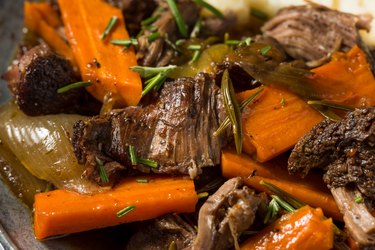
When it's cooked properly, pot roast is classic comfort food. It's lush, rich, and fork-tender, a perfect accompaniment to gravy and mashed potatoes. But if it's not cooked correctly, that same cut of meat can be distressingly tough, chewy or dry.
Video of the Day
Video of the Day
A failed pot roast can result from undercooking, overcooking or choosing the wrong cut of meat, so before you can fix it you'll need to figure out where you went wrong.
Is the Pot Roast Underdone or Overdone?
To learn whether your roast is underdone or overdone, cut away a slice or two. An underdone pot roast will be dense and somewhat leathery. An overdone pot roast will appear dry and its muscle fibers will flake and separate as you slice, like a dry holiday turkey.
Once you've performed this test, it's time to launch your rescue operation.
How to Fix Undercooked Pot Roast
You can absolutely fix an underdone pot roast, as long as you still have some time on your hands. All you need to do is continue cooking it. Pot roasts are usually tough cuts, full of dense muscles and connective tissue. They need long, slow cooking to soften the muscles and melt the connective tissues into juicy, rich natural gelatin.
Return the pot roast to your Dutch oven, roasting pan, or slow cooker and add more liquid if it's running dry. Test it again in an hour or so. If you can easily insert a fork and twist off a tender mouthful of beef, it's ready. If not, keep cooking until you reach that point.
Tip
If you own a meat thermometer or instant-read thermometer, it should show a final internal temperature of 200 to 205 degrees F for a done pot roast.
How to Fix Overcooked Pot Roast
An overdone roast is more problematic because you can't "un-cook" it. Instead, your best bet is to mask its dryness as much as possible. Moistening the sliced beef with broth or some of its pan juices will help, especially if the pan juices still contain some of their fat. Alternatively, slice the beef as thinly as you can manage and serve it with more than the usual quantity of sauce or gravy.
If the roast won't slice without falling apart, you'll need to improvise further. Consider chopping or shredding it, then mixing it with sauce and serving it as barbecue sandwiches. Seasoned differently, it can serve as taco meat or as the filling in homemade ravioli.
Bad Cuts of Pot Roast
In some cases, your choice of cut might have doomed your pot roast from the start. For example, chuck is a popular choice for pot roast because its seams of fat and connective tissue keep it moist as it cooks. Leaner cuts — which inexperienced cooks often choose to reduce the meal's fat content — are poorly suited to long cooking because they lack those characteristics.
If you've opted for a lean cut, slicing it very thinly with a sharp knife or rotary slicer can sometimes save the day. When thinly sliced across the grain, the meat will be easier to chew. And if it's well-moistened with gravy or some other sauce, it can still make for a pleasant meal. Alternatively, choose something else for tonight's dinner and use the sliced roast for lunch sandwiches instead.